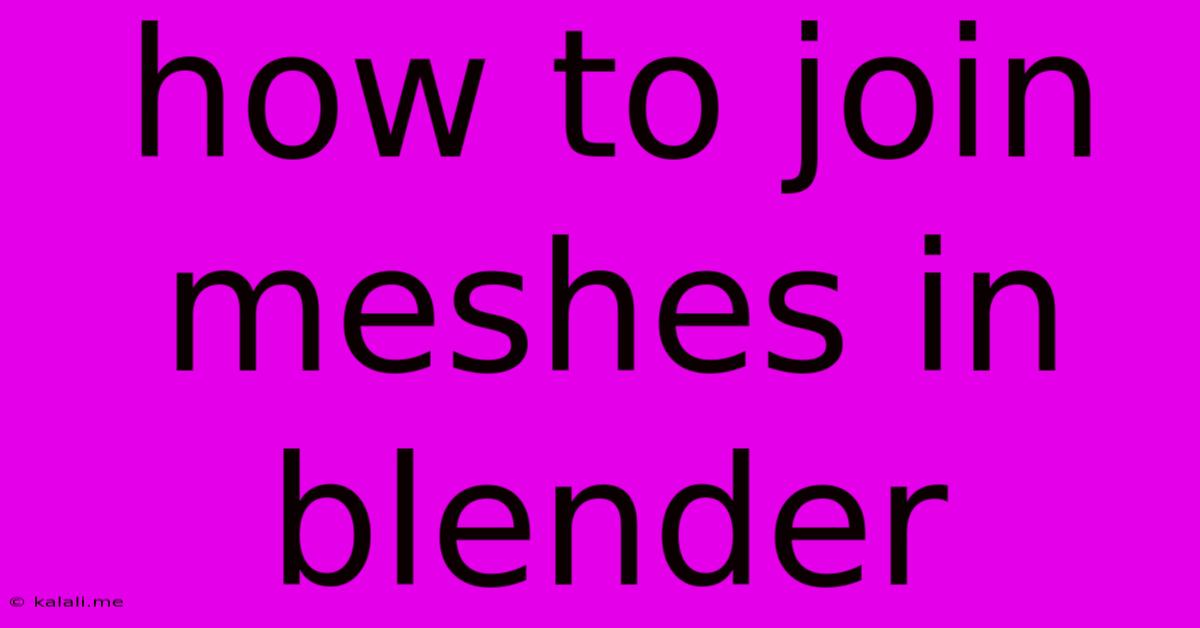How To Join Meshes In Blender
Kalali
May 25, 2025 · 3 min read

Table of Contents
How to Join Meshes in Blender: A Comprehensive Guide
Joining meshes in Blender is a fundamental task for any 3D modeling project. Whether you're combining separate parts of a character model, merging multiple objects into a single unit, or simplifying your scene for better performance, knowing how to effectively join meshes is crucial. This guide will walk you through several methods, explaining the nuances of each approach and helping you choose the best technique for your specific needs. This will improve your workflow and lead to cleaner, more efficient Blender projects.
Why Join Meshes?
Before diving into the techniques, let's understand why mesh joining is so important. Joining meshes allows you to:
- Simplify your scene: Fewer objects mean faster rendering times and a less cluttered workspace.
- Create more complex models: Combine smaller, simpler meshes to build intricate and detailed objects.
- Improve workflow: Easier selection and manipulation of combined elements.
- Apply modifiers: Some modifiers, like the Subdivision Surface modifier, work more efficiently on a single, joined mesh.
- Prepare for animation: Joined meshes streamline the rigging and animation process.
Methods for Joining Meshes in Blender
Blender offers several ways to join meshes, each with its own advantages and disadvantages. Here are the most common methods:
1. Using the "Join" Menu Option
This is the most straightforward method.
- Select the meshes: In Edit Mode, select all the meshes you want to join. Make sure they are all selected. You can use box select (B), circle select (C), or lasso select (LMB drag) to select multiple objects. Alternatively, you can select them in Object Mode and then switch to Edit Mode.
- Join the meshes: Go to the menu bar and navigate to
Object > Join. This will combine the selected meshes into a single object.
Advantages: Simple and quick. Disadvantages: Doesn't offer fine-grained control over merging vertices.
2. Using the Alt+M Shortcut
This is a faster alternative to the menu option.
- Select the meshes: Select all meshes you wish to join in either Object Mode or Edit Mode.
- Join with shortcut: Press
Alt + Mand select "Merge by distance." This will merge vertices that are close together, helping to clean up any overlapping geometry. You can also select other options like "At Center," "First," or "Last," but "Merge by distance" is typically the most useful for joining meshes seamlessly.
Advantages: Fast and efficient. Disadvantages: Still doesn't provide complete control over individual vertex merging.
3. Boolean Operations (for more complex merging)
Boolean operations (Union, Difference, Intersection) are ideal for merging meshes with overlapping or intersecting geometry. These operations modify meshes based on their spatial relationships. This is particularly useful when you need precise control over how the meshes interact during the merging process.
- Select the meshes: Select the primary mesh and then shift-select the secondary mesh you want to combine.
- Add a Boolean Modifier: Go to the Modifiers tab in the Properties panel, and add a "Boolean" modifier.
- Choose the operation: Select "Union" to combine the meshes, "Difference" to subtract the second mesh from the first, or "Intersection" to keep only the overlapping portion.
- Choose the object: Select the object you want to operate upon.
- Apply the modifier: Once you're happy with the result, apply the modifier to finalize the changes.
Advantages: Precise control over merging, perfect for complex shapes and overlapping geometry.
- Disadvantages: Can be more complex to use than simpler methods; can sometimes create artifacts that require cleanup.
Choosing the Right Method
The best method for joining meshes depends on your specific needs:
- For simple merging of non-overlapping meshes, the "Join" menu option or the
Alt + Mshortcut are the quickest and easiest choices. - For merging meshes with overlapping or complex geometry, Boolean operations offer more precise control and flexibility.
Mastering these techniques will significantly enhance your 3D modeling skills in Blender. Remember to save your work frequently, and experiment to find the workflow that best suits your style. Happy modeling!
Latest Posts
Latest Posts
-
How Do I Send An Evite Reminder
Jul 15, 2025
-
When Performing A Self Rescue When Should You Swim To Shore
Jul 15, 2025
-
How Many Decaliters Are In A Liter
Jul 15, 2025
-
What Note Sits In The Middle Of The Grand Staff
Jul 15, 2025
-
Did Lynette Shave Her Head In Real Life
Jul 15, 2025
Related Post
Thank you for visiting our website which covers about How To Join Meshes In Blender . We hope the information provided has been useful to you. Feel free to contact us if you have any questions or need further assistance. See you next time and don't miss to bookmark.